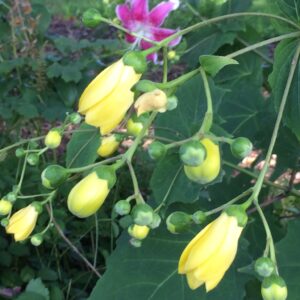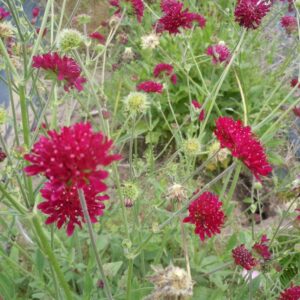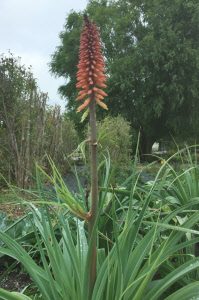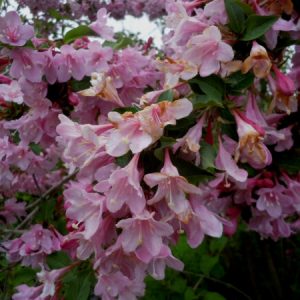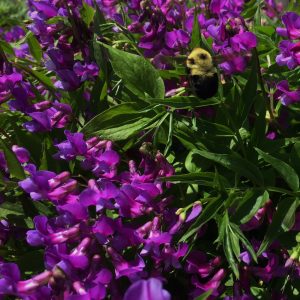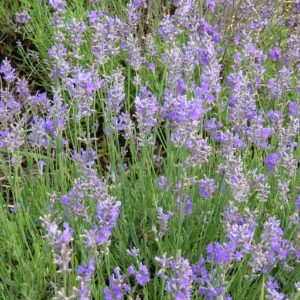Our Plants
Showing 337–344 of 587 results
-
Kirengeshoma palmata Yellow Waxbells 5-8
Moon yellow bells – gracefully droop in late summer and fall. One of internationally known garden designer Piet Oudolf’s 100 “MUST HAVE” plants, Gardens Illustrated 94 (2013)
Moon yellow bells – gracefully droop in late summer and fall. One of internationally known garden designer Piet Oudolf’s 100 “MUST HAVE” plants, Gardens Illustrated 94 (2013)
Size: 36" x 30"
Care: part shade to shade in moist to moist well-drained soil
Native: Mt. Ishizuchi in Japan
Wildlife Value: pollinated by bumblebees. deer and rabbit resistant
Awards: Royal Horticultural Society Award of Garden Merit.Kirengeshoma means “yellow” in Japanese. 1st described in Tokyo’s Botanical Society Botanical Magazine in 1890.
-
Knautia macedonica syn. Scabiosa rumelica Pincushion plant Z 5-9
Claret pincushions float at the tips of airy wands all summer & fall
Claret pincushions float at the tips of airy wands all summer & fall
Size: 2- 3’ x 10”
Care: sun in well-drained soil. Keep compact by cutting back to 10” in spring, if you wish
Native: Central Europe
Wildlife Value: attracts butterflies and beesKnautia named for German doctor & botanist Christoph Knaut (1656-1716) who published a method of classifying plants. Collected before 1879
-
Kniphofia caulescens Red hot poker, Regal torch lily Z 5-10
fat spikes of flowers open coral-red, turning pale lemon-yellow
Evergreen perennial with short, stout stems bearing grass-like broad, grey-green leaves. Blooming July to August, fat spikes of flowers open coral-red, turning pale lemon-yellow
Size: 3’ x 2-3’
Care: sun in moist well-drained soil
Native: Lesotho South Africa
Wildlife Value: deer and rabbit resistant. Attracts hummingbirds
Awards: Royal Horticultural Society Award of Garden Merit; Denver Botanic Garden Plant SelectIntroduced to gardens by Mr. T. Cooper about 1860. 1st described by French botanist Carrière in Revue Horticole in 1884
-
Kniphofia triangularis Dwarf Red hot poker Z 5-8
From early to late summer, with dead-heading, vivid coral spikes, like a torch .
From early to late summer, with dead-heading, vivid coral spikes, like a torch. This plant has everything- resistant to deer & rabbits, long blooming, great cut flowers, hummingbirds and butterflies love it.
Size: 2’ x 12-18”
Care: sun in moist to well-drained soil, Drought tolerant once established
Native: mountain grassland & moist areas in the Eastern Cape to the Northern province of South Africa.
Wildlife Value: resistant to deer & rabbits, hummingbirds and butterflies love it.1st described in 1854 in Enumeratio Plantarum Omnium Hucusque Cognitarum, Vol. 4 p. 551
-
Koeleria macrantha syn. Koeleria cristata June grass
whitish spike-like panicles
Erect ivory spike-like panicles June thru August, poke above a neat mound of erect grass blades.
Size: 2' x 18"
Care: Sun in well drained to moist well-drained soil
Native: prairies of No. America, Wisconsin native.Koeleria named by Linnaeus for grass specialist and professor at Mainz, G.L. Koeler (1765-1806). Cheyenne Indians tied June grass to the heads of Sun Dancers to deter them from getting tired and made paint brushes from it. New Mexico’s Jemez Indians made brooms from tied blades. Isleta and Havasupai Indians ate ground seeds in bread and as mush. Liberty Hyde Bailey (1933) said: “Sometimes cultivated for lawn decoration in open dry ground.” Meriwether Lewis collected this at Camp Chopunnish in Idaho on June 10, 1806 while waiting for snow melt to safely cross the Bitterroots on the expedition’s way home.
-
Kolkwitzia amabilis syn Linnaea amabilis Beautybush Z. 5-9 SHRUB
Profuse pale to dark pink bell flowers with yellow throats grace this arching shrub in early summer
Profuse pale to dark pink bell flowers with yellow throats grace this arching shrub in early summer
Size: 10’ x 12’
Care: Full sun in well-drained soil. Flowers on last season’s wood so prune just after blooms fade.
Native: China
Wildlife Value: attracts butterflies, and beesNamed for Richard Kolkwitz, (1873-19560 botany professor in Berlin. First introduced to the West by Ernest Henry “Chinese” Wilson who found it in the mountains near Ichang and sent its seeds to the Veitch Nursery in England in 1901. Harvard’s Arnold Arboretum received the shrub in 1907. It was one of Wilson’s favorite plants out of his hundreds of finds. Wilson wrote, “(a)mong the deciduous-leaved shrubs that central and western China has given to American gardens Kolkwitzia stands in the front rank.” Arnoldia 68/2.
**LISTED AS OUT OF STOCK BECAUSE WE DO NOT SHIP THIS ITEM. IT IS AVAILABLE FOR PURCHASE AT OUR RETAIL LOCATION.
-
Lathyrus vernus Spring vetchling, Spring pea, Spring vetch Z 4-9
Bushy plants bear showy, red-purple pea-like blooms age to rich purple in March-June. Spring gem.
OUT OF STOCK
Bushy plants bear showy, red-purple pea-like blooms age to rich purple in March-June. Spring gem.
Size: 10” x 10”
Care: sun in north to shade in south, moist well-drained soil. Drought tolerant once established
Native: No. Europe - Siberia
Awards: Royal Horticultural Society Award of Garden Merit, Elisabeth Carey Miller Botanical Garden Great Plant PicksIntroduced to gardens before 1629 when herbalist John Parkinson (1567-1650) called it “Blew Everlasting Pease.”
-
Lavandula angustifolia ‘Munstead’ Z 5-9
Very fragrant, compact form of Lavender blooms in wands July-September.
Very fragrant, compact form of Lavender blooms in wands July-September.
Size: 12-18” x 12-18”
Care: Sun, well-drained, soil. Prune to 8” in spring every 2 years to control plant size and promote new growth.
Native: species native to Western Mediterranean
Wildlife Value: Attracts many different bee species and butterflies. Resistant to rabbits and deerThis selection introduced to gardens in 1916. Named for Munstead Woods in England, the home of the extraordinary garden designer Gertrude Jekyll (1843-1932) Lavandula is Latin from lavare meaning “to wash” because it was thrown into baths for the scent, “or because used in lye to give a fragrancy to linen; and because it is very good to wash the face with, and give it both beauty and a grateful scent.”

